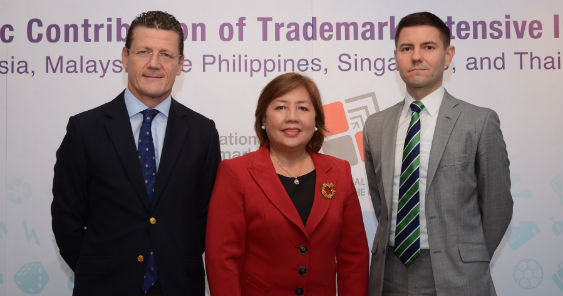The International Trademark Association (INTA) has released the results of an impact study which revealed the major direct and indirect contributions of industries that intensively use trademarks to the Gross Domestic Products (GDP) of the five major economies in the Association of Southeast Asian Nations (ASEAN). The report, “The Economic Contribution of Trademark-Intensive Industries in Indonesia, Malaysia, the Philippines, Singapore and Thailand”, prepared by Frontier Economics for the INTA revealed that aside from having a significant contribution to the GDP, trademark-intensive industries increased employment and further contributed to international trade.
The study is the first of its kind in the region to determine the correlation between trademarks and their economic contribution to the GDP, employment, and share of exports in the five biggest markets in the Southeast Asia. Trademark-intensive industries are defined as those industries which file more trademarks than others and an above-average use of trademarks per employee.
According to the report, trademark-intensive industries’ direct contribution to Philippine GDP stands at 17%, while indirect contribution is at 41%. These industries generate 15% of employment opportunities and accounts for 47% share of exports.
Direct contributions are defined in terms of employment, output and value-added generated by any particular trademark-intensive industry, while indirect contributions reflect interdependencies, through the purchase and sale of inputs, between trademark and non-trademark intensive industries.
While the report has been encouraging in terms of having definite and quantifiable numbers for the economic contribution of trademark-intensive industries to GDP, it has also revealed that the Philippines has the lowest statistics compared with the other four major ASEAN markets. Trademark-intensive industries in Singapore gave a 50% direct contribution to GDP, and 55% indirect contribution. Malaysia came in second with a 30.3% direct contribution to GDP and a significantly higher indirect contribution statistic at 60%.
Manufacturing is the biggest trademark-intensive industry in all five markets, but less pronounced in Singapore, where services are also heavy users of trademarks. In four economies, computer, electronics, and related equipment make up a big chunk of manufacturing trademarks. However, in Indonesia, food products are the dominant trademark-intensive activity.
In the Philippines, the main trademark-intensive sector is manufacturing, where information and communications, and construction activities contribute heavily to trademark-intensive activities. The dominant sub-sector in trademark-intensive manufacturing is computer, electronics, and related equipment. According to the report, econometric analysis suggests a strong trademark effect in the Philippines which means businesses that trademark their products will have a 100% increase in value-added per worker.
With these results, James Allan, Australia and Asia Director for Frontier Economics, suggested that there is a significant opportunity for the Philippines to attract electronic manufacturers
Intellectual Property Office of the Philippines (IPOPHL) Director General Josephine Santiago welcomed the results of the report and emphasised its importance as a “concrete, empirical study showing economic contribution of intellectual property rights, specifically trademarks.” She added, “we have been emphasising the contribution of intellectual property (IP), including trademarks, to the country’s economic development. We welcome this evidence-based study by INTA because it shows that there is a correlation between trademarks and economic development based on hard data. We hope that with a National Intellectual Property Strategy, which will be completed next year, we can further engage our stakeholders in making better use of the trademark system and contribute to economic development.”
She further saw the results of the study as encouragement for more businesses, especially Small Medium Enterprises (SMEs) and Micro Small Medium Enterprises (MSMEs) to trademark their products and services. “IPOPHL is in the forefront of leading the pack in terms of making the public know the importance of intellectual property. We want to have programs that would translate into something more understandable, including SMEs, MSMEs, which is an important program of the present administration. IP needs to be protected, there should be enforcement of rights of owners. This is not just protecting multinationals, but our MSMEs as well,” she said.
In a statement, INTA CEO Etienne Sanz de Acedo further added that the results of the study “underscore the immense potential for cross-sectoral economic growth that can be unlocked by promoting the value of trademarks with the business community, government, and the general public, and by further developing national trademark systems and trademark-intensive industries. As we explore the long-term economic and social implications of trademarks and related intellectual property rights, it becomes increasingly important for both public and private sectors to scale up engagement on this issue, as well as support government efforts to further trademark and brand development and protection, including protection of goods in transit.”
Why trademark
Trademarks are closely related to brands. Having a strong brand can give a competitive advantage to a business over another. “A trademark is a business identifier, like your own name. No matter where you are in the supply chain, it is important that you brand your products. Go to social media; this is the only way for consumers to identify your products. This is going to bring consumer and brand equity and brand loyalty,” Sanz de Acedo said. “How are you able to purchase a product over another? A brand or trademark is critical. It does not only help the businesses to grow, it helps the economy to grow, it helps employment to grow” he stressed.
Santiago added, “MSMEs and even those that are in business are not keen in having trademarks because they don’t see the need. Having a trademark will give the MSME a competitive advantage. If you have a name unique to you, it’s something consumers will remember in relation to the origin of the goods, it links the trademark to the product or service, which is the enterprise that sells these goods and services. It is the name that the public will remember.”
—
A full copy of the ASEAN impact report can be downloaded here and here to download a Philippines-focused infographic.









